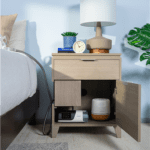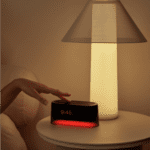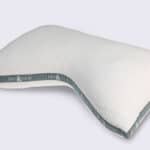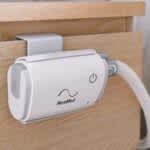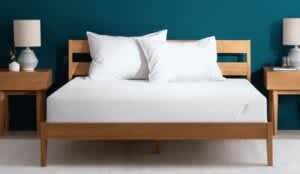Cultivating the right sleep environment is essential to maintaining your health and wellness. While choosing the best mattress for your needs involves careful research and consideration, picking a bed frame is also important. Bed frames are designed to raise the sleep surface, but they can also enhance mattress performance.
The sizes of bed frames correspond with standard mattress sizes without much deviation. These include twin, twin XL, full, queen, king, and California king. Special bed frame sizes are also available for less common mattress dimensions, such as full XL and Olympic queen.
We’ll cover common bed frame dimensions for standard mattress sizes. Additionally, we’ll explain different bed frame types and other factors that may influence which option is best for you.
What Is a Bed Frame?
A bed frame is a structure that lifts your mattress and box spring or foundation off the ground. While the box spring or foundation is intended to support the mattress and reduce signs of wear, the frame holds up the surface. That said, some frames have built-in foundations, eliminating the need for additional reinforcement.
The most basic bed frames consist of four or six legs and a rectangular base. However, some bed frames include headboards, footboards, side panels, storage, posts, or a combination of several features. Most often, bed frames consist of durable materials, like wood or metal. Upholstery is also common, though usually more expensive.
How Much Does a Bed Frame Cost?
The average cost for a bed frame ranges from $100 to over $1,000. Factors that affect the cost include the manufacturer, size, materials, and construction. Larger bed frames and non-standard sizes typically cost more than smaller options and more traditional dimensions. Sturdier materials, such as solid wood, tend to increase the price tag. Additional features, like headboards, upholstery, and underbed storage, also usually cost extra.
Are Bed Frames Necessary?
While bed frames aren’t always necessary, they have advantages. Because a bed frame lifts a mattress and its components off the ground, the surface is less likely to accumulate dust and other allergens. Air circulation around the sleep surface can also help reduce the risks of mold and mildew growth. Additionally, some mattress manufacturers require the use of a bed frame for warranty coverage.
The added height of a bed frame makes it easier for most sleepers to get into and out of bed. However, whether or not to use a bed frame ultimately boils down to personal preference.
Bed Frame
Pros
- Supportive for the box spring or foundation
- Easier to get in and out of bed
- Increased airflow
- Reduced allergen buildup
- More traditional aesthetic
Cons
- Additional expense
- Heavy to assemble and move
- May make noise, especially as it ages
What Bed Frame Sizes Are Available?
The most widely available sizes are twin, twin XL, full, queen, king, and California king. Bed frame dimensions usually correspond closely to mattress sizes. However, they often add a couple of inches on either side.
Mattress Size | Dimensions | Description |
|---|---|---|
Twin | 38″ x 75″ | Twin is the smallest standard mattress size. It is ideal for children, teens, and single adults under 6 feet tall. A twin bed is especially useful for small spaces. |
Twin XL | 38″ x 80″ | Twin XL mattresses are 5 inches longer than twin mattresses to accommodate taller sleepers. Like twin mattresses, they are appropriate for single sleepers in small spaces. |
Full | 54″ x 75″ | Full mattresses provide more room for single sleepers under 6 feet tall to spread out. They can also accommodate two sleepers, but adults may be a little cramped. Full size beds fit easily in most average-sized bedrooms. |
60″ x 80″ | Queen mattresses are slightly wider and longer than fulls, making them the most popular choice for couples. Two average-sized adults can comfortably sleep on a queen. Queen beds fit well in most bedrooms without overwhelming the space. | |
76″ x 80″ | King mattresses are significantly wider than queens, giving couples more space to spread out. King is the widest standard size and requires a larger room to fit comfortably. | |
California King | 72″ x 84″ | California king beds are longer and narrower than regular kings. They are a good choice for tall couples. However, they may not be ideal for small bedrooms. |
What About Non-Standard Bed Frame Sizes?
Non-standard mattress sizes require appropriately sized frames. However, they can be hard to find. Specialty bed frames and custom options are available online for oversized beds, like Wyoming kings and Alaska kings. These typically cost more than more conventional options.
How Tall Are Bed Frames?
Bed frames are usually between 12 and 16 inches tall, which is approximately knee level. Mattresses are typically 9 to 12 inches tall. The combined heights of the frame and mattress should generally allow an average adult to sit on the edge of the bed with their feet flat on the floor. However, bed frame options are available to accommodate different preferences. For example, many platform beds have a low profile for a more minimalist aesthetic, and higher bed frames can accommodate taller individuals and extra underbed storage.
What Bed Frame Types Are Available?
A variety of bed frame types are available. Whether you’re looking for basic and affordable, minimalist, classic, or extravagant, there is a bed frame suitable for your aesthetic and function.
Platform
As their name suggests, platform bed frames include a platform composed of horizontal slats or a solid base for support. Owners can then forego a box spring or other foundation and place their mattress on the frame.
Sleigh
Sleigh bed frames have curved headboards and footboards designed to look like sleighs. These beds are traditionally made of solid wood and are quite heavy. However, sleigh beds made of other materials, like metal and upholstery, are gaining popularity.
Panel
A panel bed frame combines a headboard, footboard, two side panels, and a base to create a sturdy structure. Panel beds usually require a box spring or similar foundation to support the mattress. This type of frame is often made of solid wood or metal.
Four-Poster
Four-poster beds get their name from their corner posts. These posts may be decorative or provide support for a canopy or curtains.
Bunk
Bunk beds are made up of multiple bed frames assembled one over the other to save space. A ladder makes the upper bunk accessible. Usually, bunk beds use twin mattresses, but other sizes are available. They are popular for families with multiple children.
Trundle
Trundle bed frames are rolling platforms designed to be stored under another bed. They are ideal for those with limited space who plan to host guests.
Adjustable
Adjustable bed frames usually allow the elevation of the head and foot of the bed. This is particularly useful for snorers and chronic pain sufferers.
What Bed Frame Size Should You Buy?
Select a bed frame size that fits your mattress, room, and personal needs. While this may seem simple, it requires careful consideration of key factors.
Check Your Mattress Size
Confirm that the bed frame size matches your mattress size. You can generally expect frames and mattresses of the same standard sizes to work together. The size chart above can act as a reference. However, it also doesn’t hurt to measure your mattress dimensions just in case.
If your mattress is oversized or custom, it’s especially important to know the dimensions before purchasing a frame.
Consider Your Needs
Look for bed frames with the right support, height, and style for you.
If you plan to use your mattress without a box spring or foundation, you need to ensure the frame incorporates built-in support to prevent the mattress from sagging. Bed frames also often have weight limits. Add up the combined weights of the sleepers and mattress to ensure you get a sturdy enough frame.
The height of the bed frame may also make a difference. If you struggle to get into and out of a low sleep surface, a higher frame may be helpful. However, if you’re short or have an especially thick mattress, a lower frame may put the surface at a more comfortable height.
Additionally, consider your bedroom design to choose a bed frame that matches your style preferences.
Measure Your Space
Some bed frame styles take up more space than others. For example, if you have low ceilings, a four-poster bed frame with tall columns might not be the best choice. Measure the height, width, and length of the area you can dedicate to your bed, and choose a bed frame that fits.
Set Your Budget
A bed frame generally costs at least $100. If you’re purchasing other components to complete your new setup, don’t forget to also budget for them. This may include the mattress, box spring or foundation, and bedding.
Ask the Sleep Doctor
Have questions about sleep? Submit them here! We use your questions to help us decide topics for articles, videos, and newsletters. We try to answer as many questions as possible. You can also send us an email. Please note, we cannot provide specific medical advice, and always recommend you contact your doctor for any medical matters.














